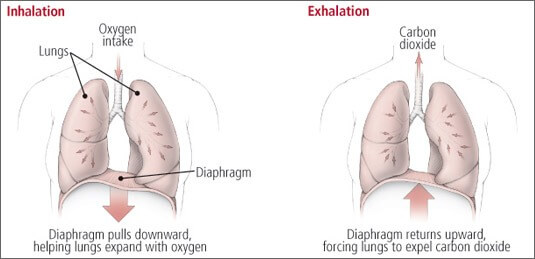Free Ways to Correct Oxygen Deficiency: Part 2
The first step to correcting common oxygen deficiency is to create habits in your daily life that will increase oxygen naturally. You can find them explained further in our video: “Free Ways To Increase Your Oxygen Level.”
Oxygen is the world’s most basic fuel! Every cell in your body needs oxygen as a fuel supply. A number of factors contribute to oxygen deficiency in people who lack oxygen, including:
- Eating cooked food,
- Not breathing from the diaphragm,
- Eating animal products and processed food,
- Living a sedentary lifestyle,
- Living in houses full of stagnant, oxygen-depleted air,
- Living in cities full of stale oxygen-depleted air.
In this six-part series, we look at each of these in more detail. Today’s topic is oxygen and breathing.
Free Ways to Correct Oxygen Deficiency, Part 2: Breathing
Many diseases cannot exist in an adequately oxygenated body, so hyperbaric oxygen chambers are powerful life-saving tools in hospitals. The more oxygen available to your body, the healthier it can be.
Did you know you learned breathing patterns from your family? If your caregivers were deep breathers, you learned how to breathe deeply by mimicking what you saw. If they were shallow breathers, then you learned that also. The good news is that you can create new breathing habits.
Shallow breathing, thoracic breathing, or chest breathing is drawing air into the chest area using the intercostal muscles (upper chest muscles) rather than the full lungs, which means using the diaphragm. The diaphragm is the muscle located at the bottom of the rib cage, horizontally between the chest cavity and stomach cavity.
On the other hand, diaphragmatic, abdominal, and belly breathing, also called deep breathing, are taking breaths done by contracting and relaxing the diaphragm. When a deep breath is taken using the diaphragm, air enters the lungs, and the belly must expand.
“This deep breathing is marked by the expansion of the abdomen rather than the chest when breathing. It is considered by some to be a healthier and fuller way to ingest oxygen and is sometimes used as a therapy for hyperventilation, anxiety disorders, and stuttering.”
Basic Diaphragmatic Breathing to Improve Oxygen Deficiency
The basic steps to do deep breathing from the diaphragm are:
- Sit or lie comfortably with loose garments.
- Put one hand on your chest and one on your stomach.
- Slowly inhale through your nose or pursed lips (to slow down the intake of breath).
- As you inhale, push your belly/ stomach out and feel your stomach expand with your hand.
Breathing exercises such as this one should be done twice a day or whenever you find your mind dwelling on upsetting thoughts or when you are experiencing pain. Breathing is the most basic way to combat common oxygen deficiency. The following is an excerpt from the article Breath Work – Breathing Exercises at HappyHealthyHer.com:

Abdominal Breathing Technique
Place one hand on your chest and the other on your abdomen. When you take a deep breath, the hand on the abdomen should rise higher than the one on the chest. This ensures that the diaphragm is pulling air into the bases of the lungs.
Take a deep breath in through your nose, imagining that you are sucking in all of the air in the room, and hold it for seven seconds (or as long as you are able, not exceeding seven seconds.)
Slowly exhale through your mouth for a count of 8. As all the air is released with relaxation, gently contract your abdominal muscles to completely evacuate the remaining air from the lungs. It is important to remember that we deepen respirations not by inhaling more air but by completely exhaling it.
Repeat the cycle four more times for a total of 5 deep breaths, and try to breathe at a rate of one breath every 10 seconds (or six breaths per minute). Our heart rate variability increases at this rate, which positively affects cardiac health.
Next Steps
Once you feel comfortable with the above technique, you may want to incorporate words that can enhance the exercise. Examples would be to say to yourself the word relaxation (with inhalation) and stress or anger (with exhalation). The idea is to bring in the feeling/emotion you want with inhalation and release those you don’t want with exhalation.
In general, exhalation should be twice as long as inhalation. The use of the hands on the chest and abdomen is only needed to help you train your breathing. Once you feel comfortable with your ability to breathe into the belly, they are no longer required.
Abdominal breathing is just one of many breathing exercises. But it is the most important one to learn before exploring other techniques. Practice will improve the body’s internal rhythm as it becomes more natural.
As a supplement to any deep breathing exercise routine, OxygenSuperCharger™ can be used to increase your body’s available oxygen.
How do you get into the habit of breathing more deeply? Place objects or a few sticky dots in places you will see each day: on your review mirror, next to your computer monitor, or above your kitchen sink. Take a few deep diaphragm breaths when you see them—the most simple and basic way to combat oxygen deficiency.
In Part 3, we will examine free ways to increase oxygen and how eating animal products and processed food decreases available oxygen.

-

Ultra Strength OxygenSuperCharger2, 25% Stronger, 16–Ounce Bottle
$119.97 Add to cart -

Ultra Strength OxygenSuperCharger2, 25% Stronger, 2–Ounce (Sample Size)
$35.97 Add to cart -

Original 35% Strength OxygenSuperCharger, 16–Ounce Bottle
$96.97 Add to cart -

Original 35% Strength OxygenSuperCharger, 2–Ounce (Sample Size)
$27.97 Add to cart -

MineralSuperCharger, Premium Multi-Mineral Supplement, 32-Ounce Quart
$98.97 Add to cart -

MineralSuperCharger, Premium Multi-Mineral Supplement, 8-Ounce (Sample Size)
$29.97 Add to cart -

Zinc – Plant-Sourced Mineral Concentrate, 16-ounce
$24.97 Add to cart -

O4 Nasal Spray with Zinc
$14.97 Add to cart







